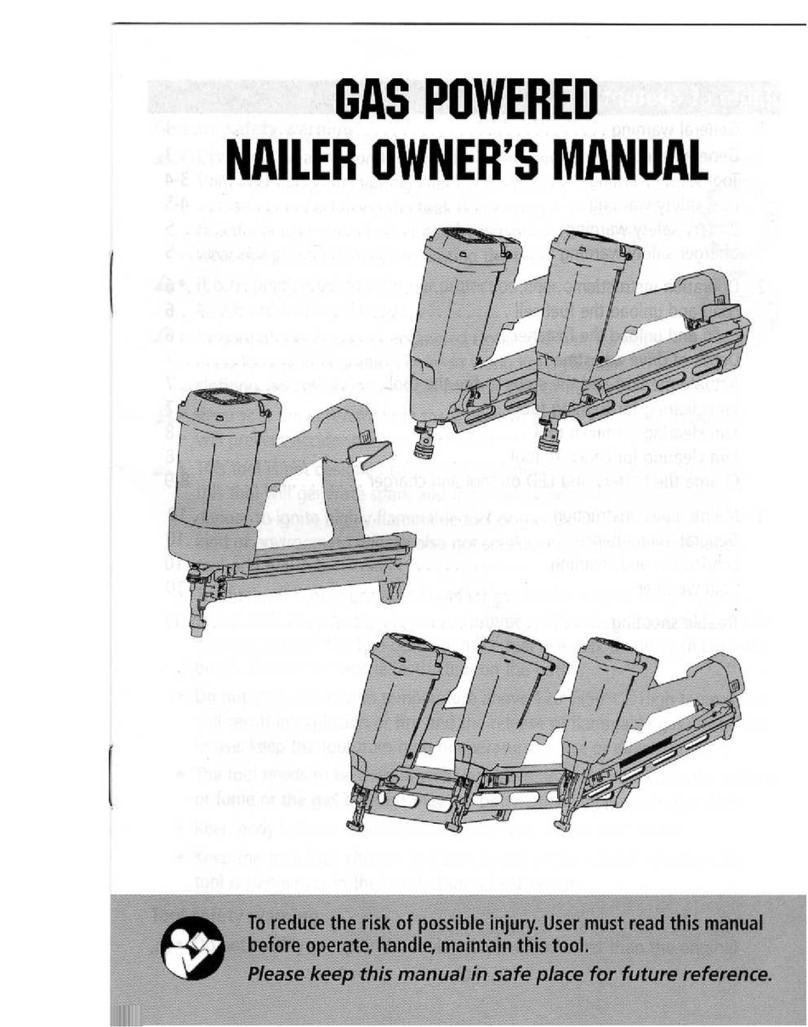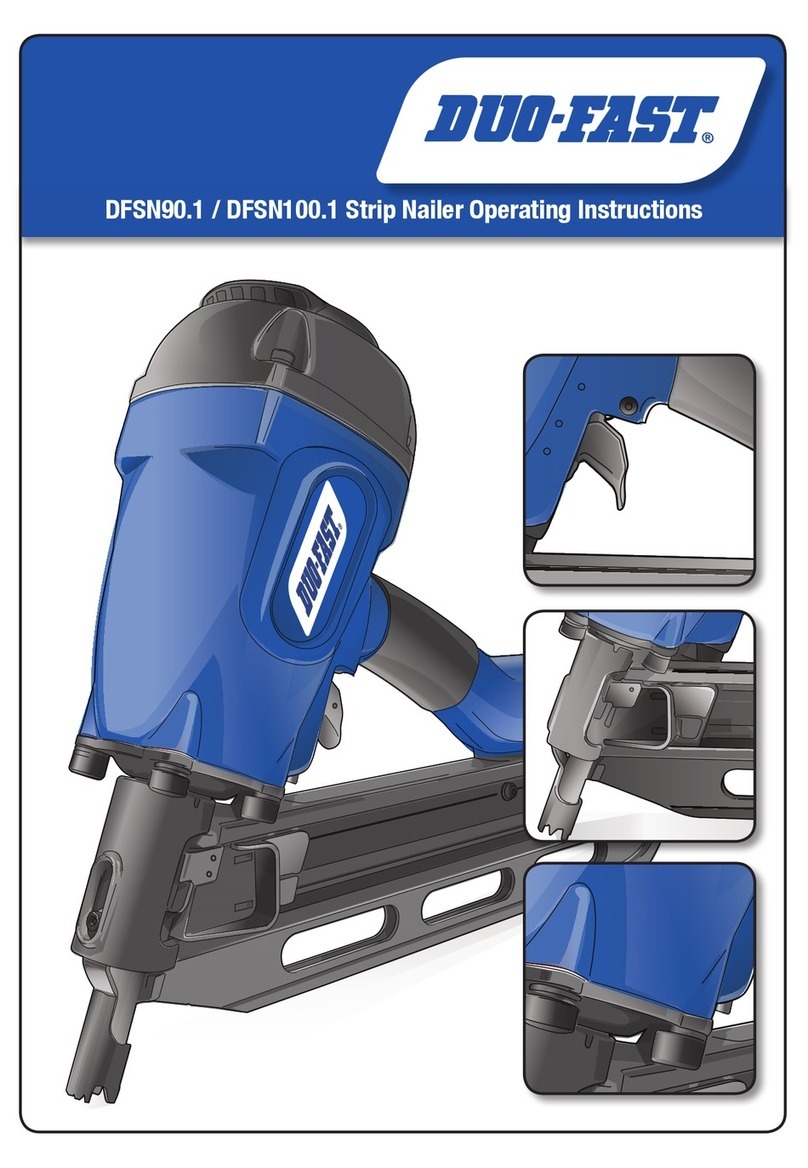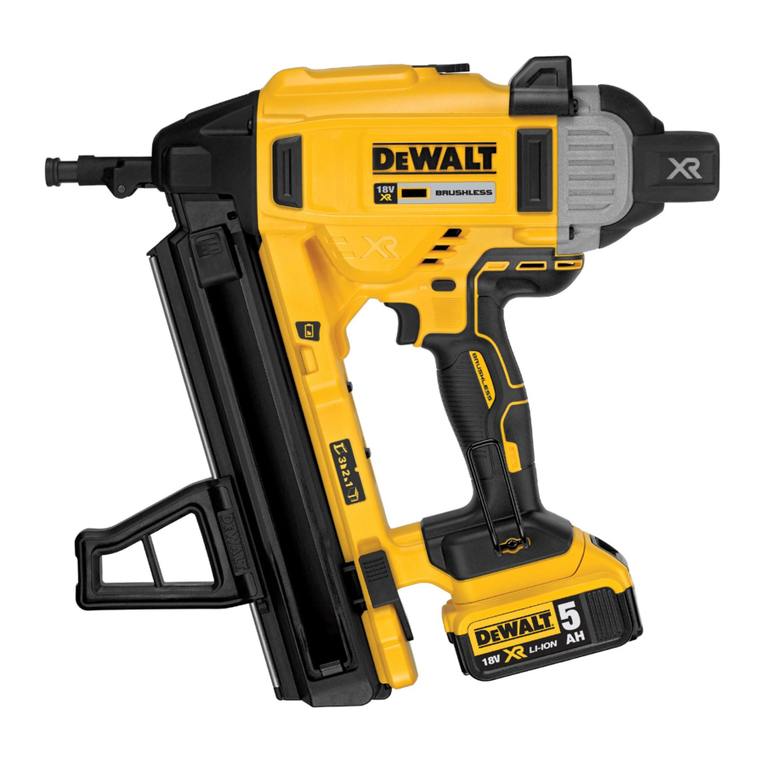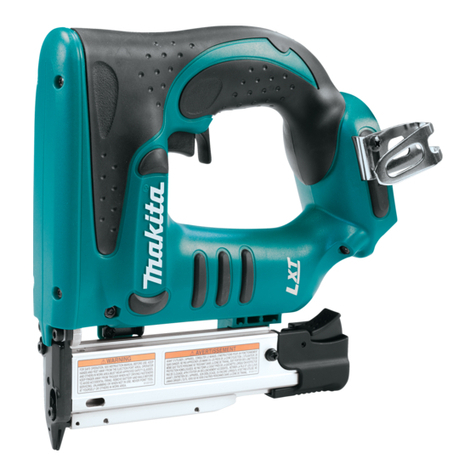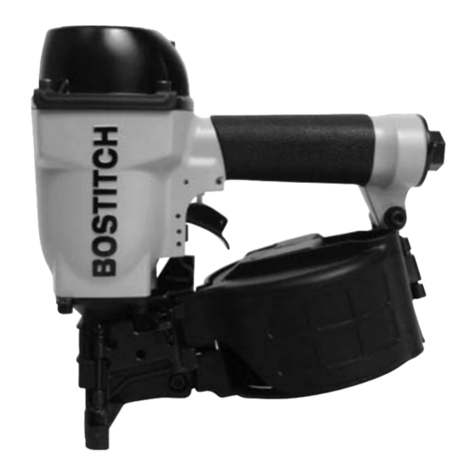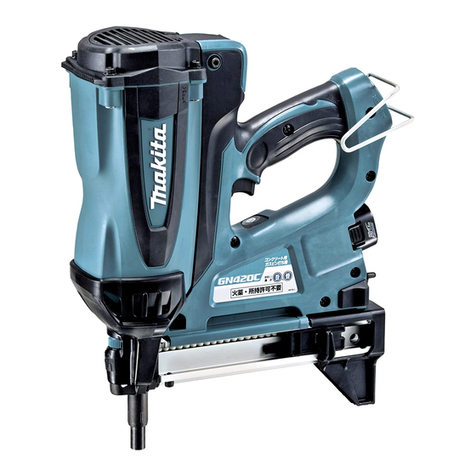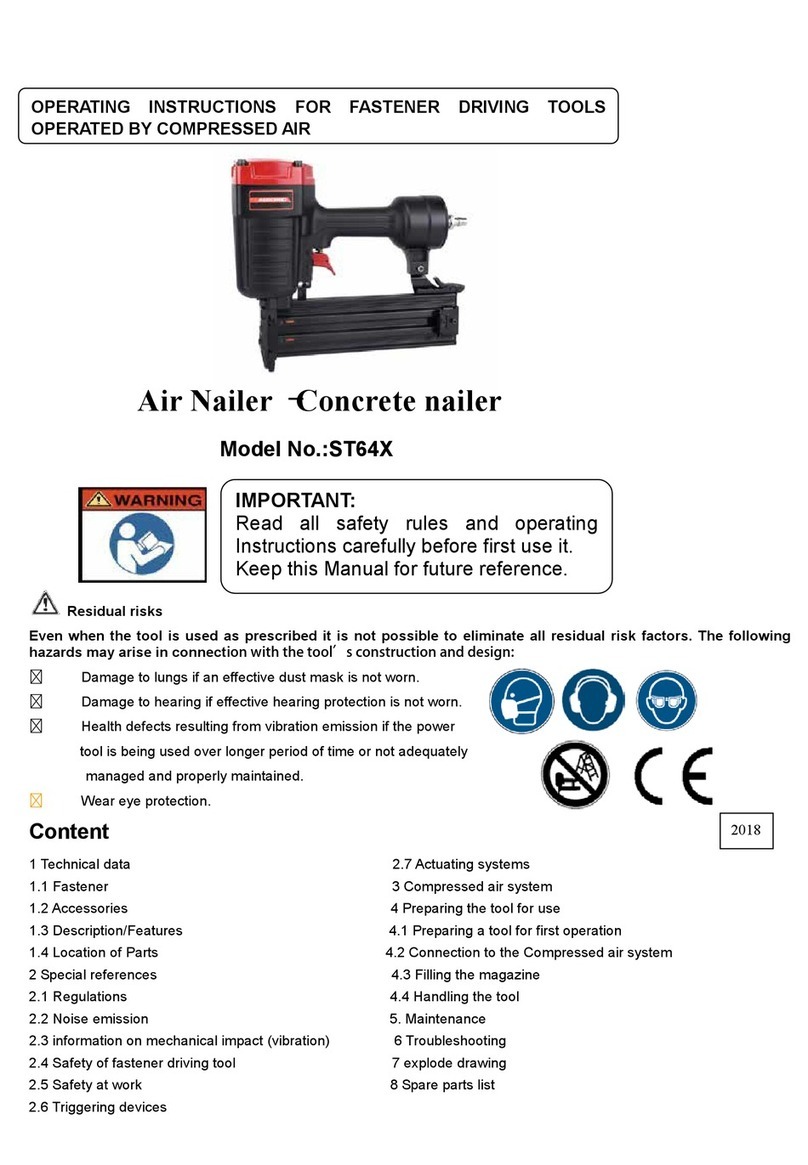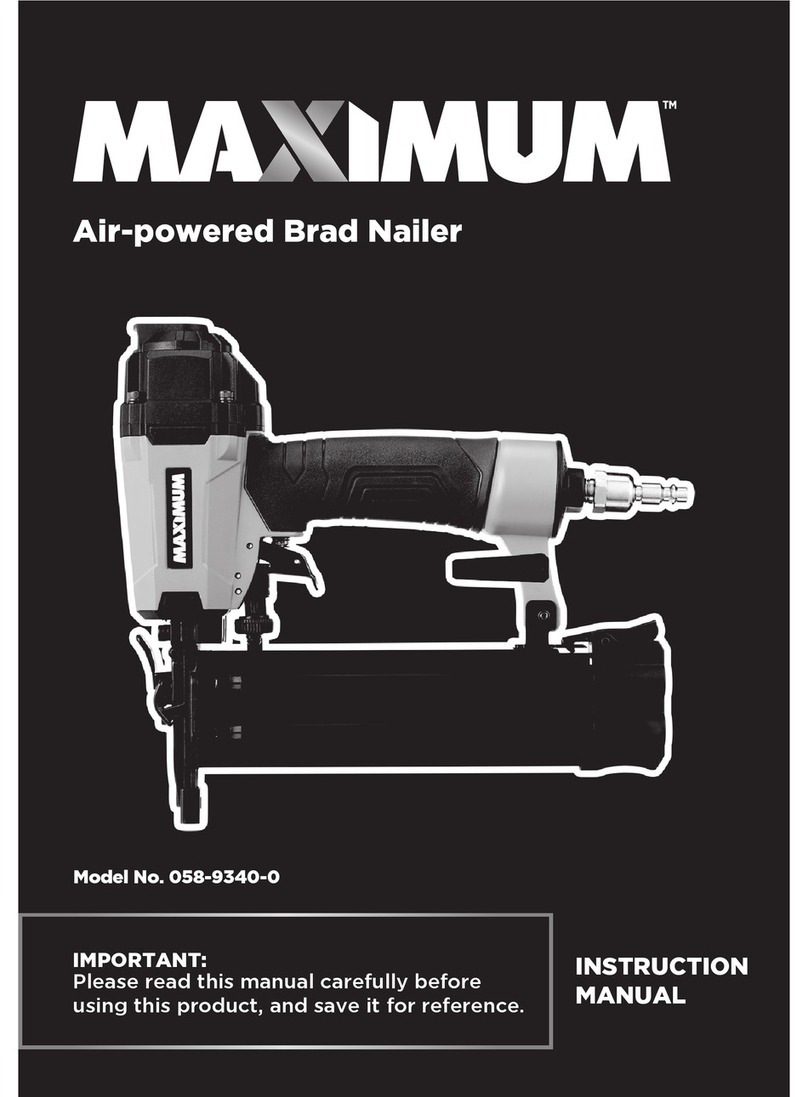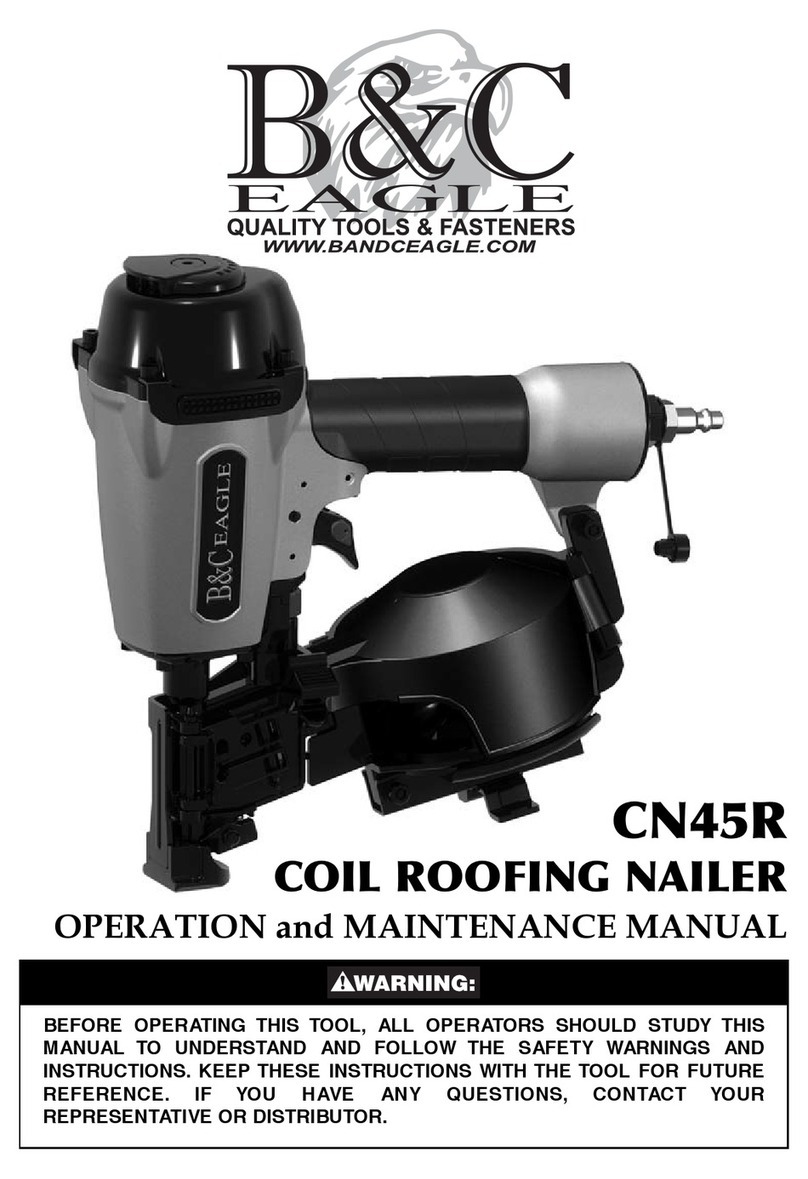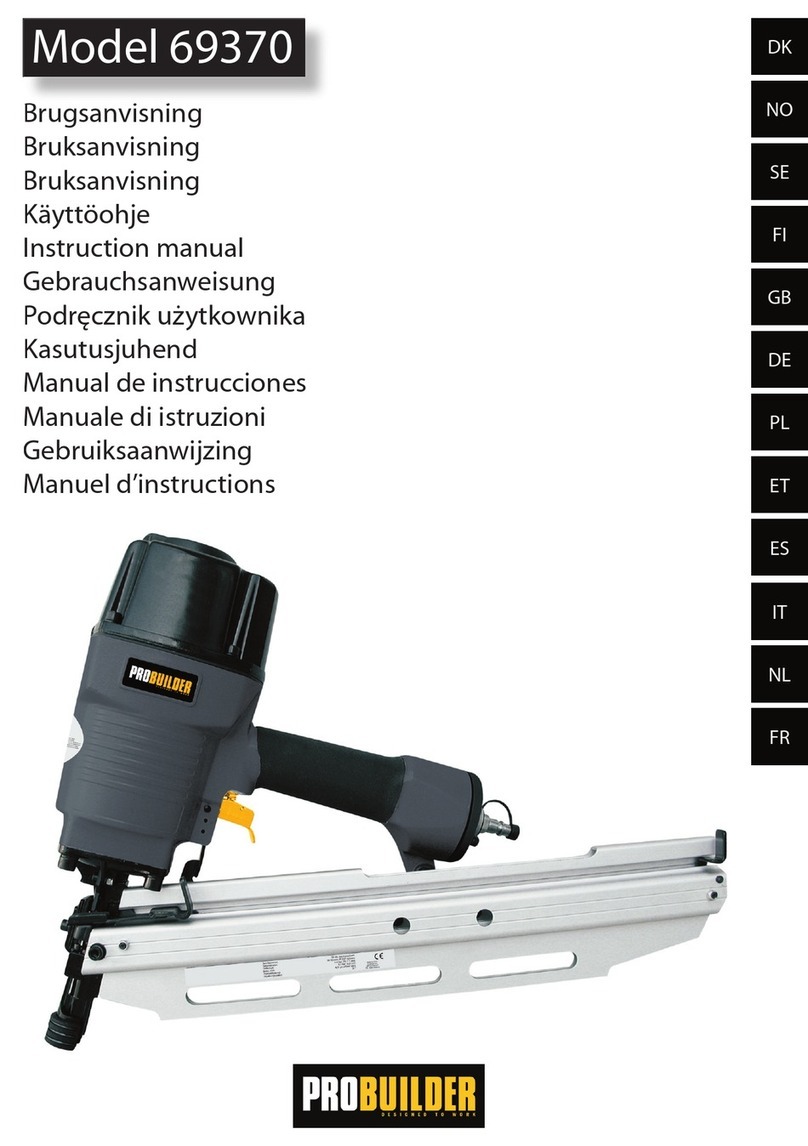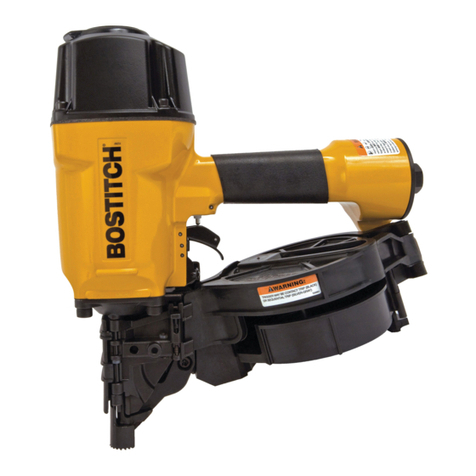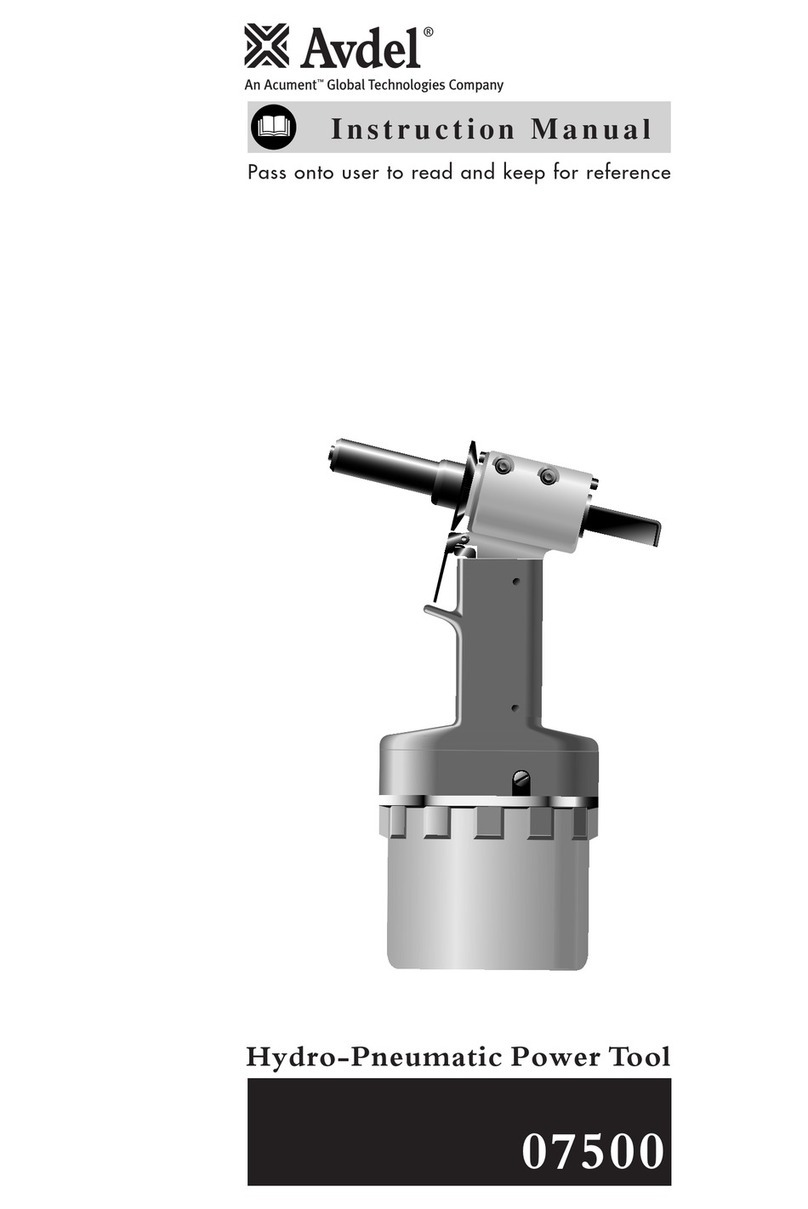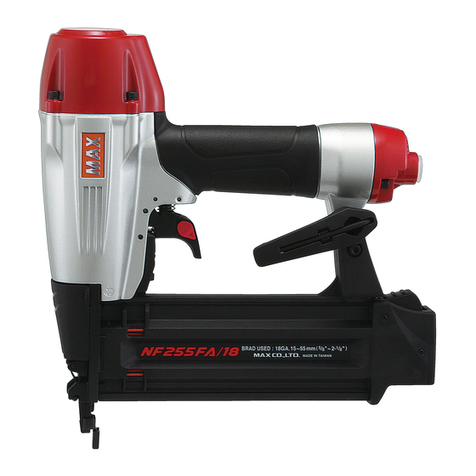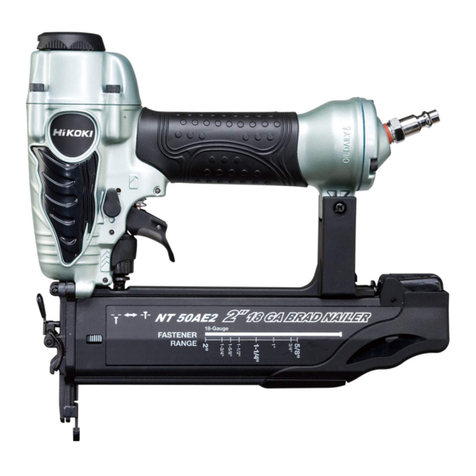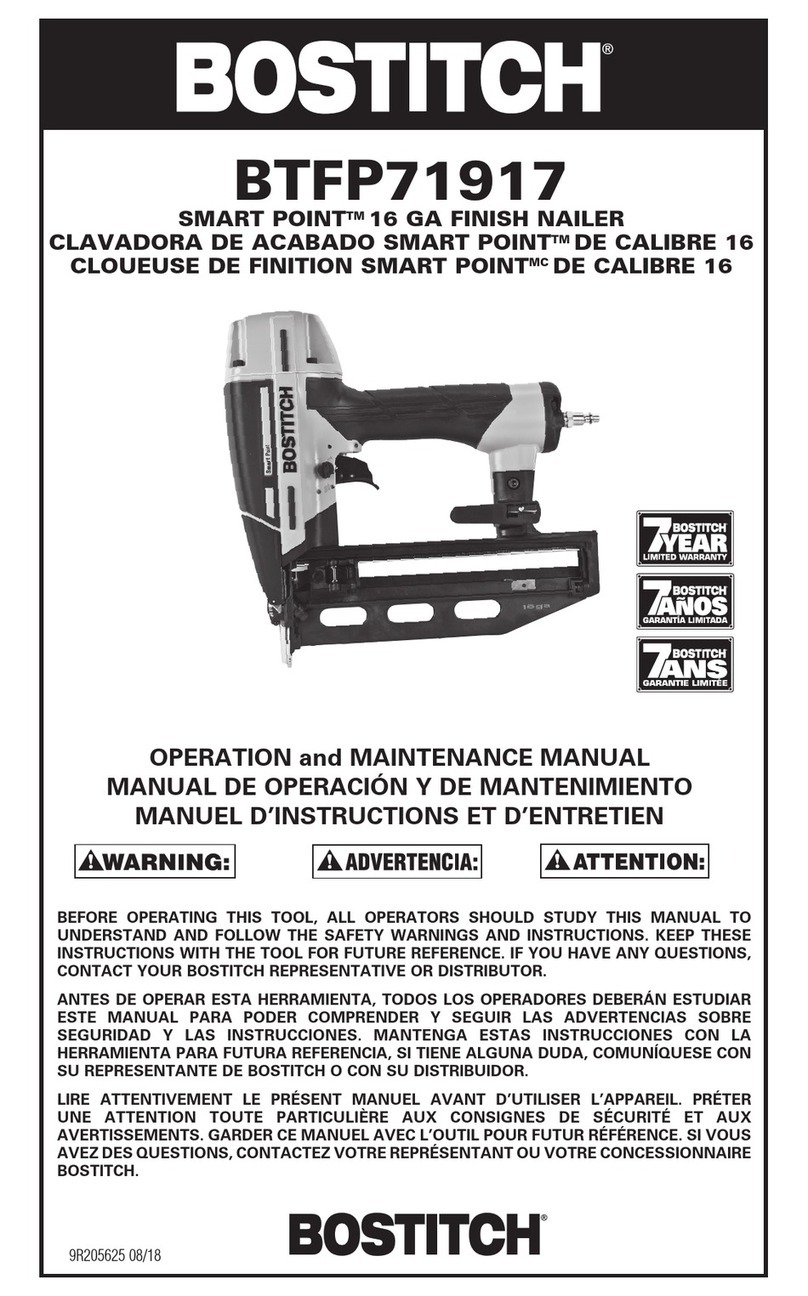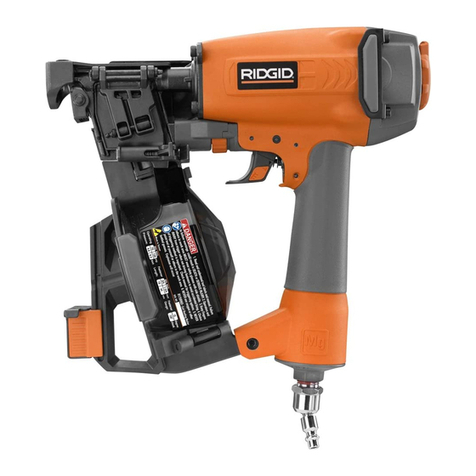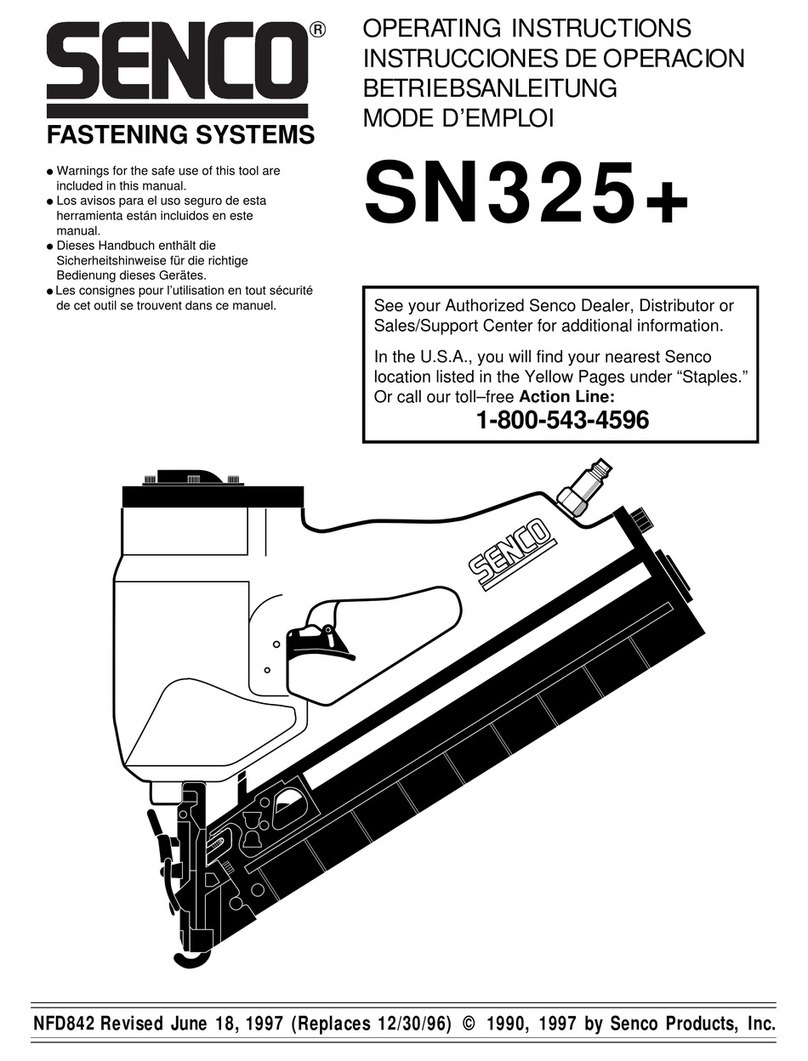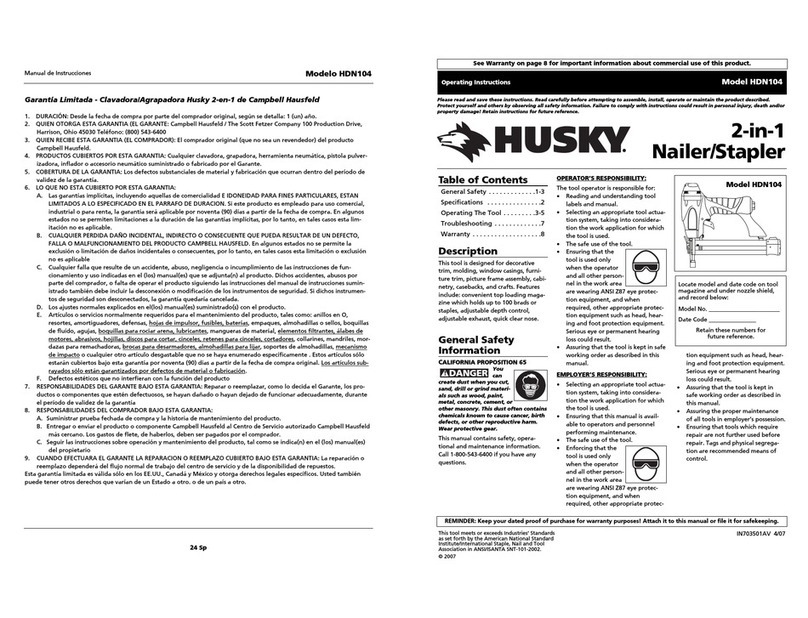BluePoint Fasteners GT-100L Guide

GAS CONCRETE NAILER
MODEL GT-100L
SAFETY OPERATION MANUAL

CONTENTS
ITEM PAGE
1. 1
2. SPECIFICATION 6
3. GENERAL OPERATION MANUAL 8
4. 16
MAINTENANCE ..........................................
SAFETY ....................................................
........................................
............
5. EXPLODED DRAWING AND PARTS LIST ... 20
IMPORTANT INFORMATION: MUST READ
BEFORE YOU START
Read and understand tool labels
and all of operating instructions,
safety precautions and warnings in
this manual before operating or
maintaining this nailer.
Failure to follow warnings could result in DEATH
or SERIOUS INJURY.
Most accidents that result from the operation and
maintenance of Nailers are caused by the failure
to observe basic safety rules or precautions. An
accident can often be avoided by recognizing a
potentially hazardous situation before it
occurs, and by observing appropriate safety
procedures.
Basic safety precautions are outlined in the
“SAFETY” section of this Manual
Hazards that must be avoided to prevent bodily
injury or machine damage are identified by
DANGERS and WARNINGS on the Nailer and in
this Manual
Never use this Nailer for applications other than
those specified in this Manual.
EXPLANATION OF TERMINOLOGY
DANGER indicates an imminent hazardous situation
which, if not avoided, will result in death
or serious injury.
WARNING indic at es apot enti al ly hazardous
situation which, if not avoided, could
result in death or serious injury.
CAUTION indic at es apot enti al ly hazardous
situation which, if not avoided, may
result in minor or moderate injury, or
may cause machine damage.
NOTE emphasizes essential information.
EXPLANATION OF THE FUNCTION OF THE
GT-100L NAILER
This tool has a FULL SEQUENTIAL ACTUATION
MECHANISM. Fully depress the tool against the work
surface and actuate the trigger. Follow the same
sequence to continue driving nails after the push lever
and trigger are return back in place.
SAFETY
IMPORTANT SAFETY INSTRUCTIONS FOR
USING NAILERS
READ ALL INSTRUCTIONS
This Nailer is powered by internal
combustion device.
This Nailer shall only be used with
dispensers for combustible gas
which are listed in this manual.
DANGER
1. OPERATORS AND OTHERS IN WORK AREA
MUST WEAR SAFETY GLASSES WITH SIDE
SHIELDS.
When operating the Nailer, always
wear safety glass es with side
shields, and make sure others in
work area wear safety glasses.
Safety glasses must conform to the requirements
of American National Standards Institute,
ANSI Z87.1 and provide protection against flying
particles both from the front and side.
T h e e m p l o y e r m u s t e n f o r c e t h e u s e o f
safety glass es by the Nail er operator and
others in work area.
2. NEVER USE IN PRESENCE OF FLAMMABLE
LIQUIDS OR GASES.
This Nailer must not be used in a
c o m b u s t i b l e e n v ir o nment or in
presence of flammable liquids or
gases, e.g. lacquer, paint, benzine,
thinner or gasoline.
This Nailer produces hot exhaust gases that
may ignite flammable materials and also
produces sparks during operation.
3. DO NOT TOUCH AROUND THE EXHAUST
OUTLET.
This Nailer produces hot exhaust
gases that may ignite flammable
materials. Th e f iri n g headand
n os e w il l become hot and get
heated up after prolonged or rapid
use. Do not touch with bare hands.
4. EXPLOSION AND FIRE HAZARD.
The fuel cell is an aerosoldispensers
with flammable contents.
Pre ssu red container and the
propellant will remain in the fuel cell.
Faillure to follow instructions may
result in explosion or fire.
1

(50℃)
Keep the Nailer, fuel cells and battery
120°F MAXawa y fr om suns hine and from
te m pe r at u re e xc eeding 120°F
(50°C).
Fuel cell and/or battery may burst,
releasing flammable gas.
Do not pierce or burn the container,
even afteruse.
Do not incinerate, refill, reclaim
or recycle the fuel cell.
Do not spray to a naked flame or any
incandescent material.
Keep away from ignition sources
No smoking.
Keep out of the reach of children.
WARNING
5. NEVERPOINT TOOL AT YOURSELF OR OTHERS
IN WORK AREA.
Always assume the Nailer contains
fasteners.
Never point the Nailer at yourself or
others, whether it contains fasteners
or not.
If fasteners are mistakenly driven, it can lead to
severe injuries.
Never engage in horseplay with the Nailer.
Respect the Nailer as a working implement.
6. K E E P F I N G E R S A WA Y FROM TRIGGER
W H E N N O T D R I V I N G F A S TE N E RS T O
AVOID ACCIDENTAL FIRING.
Never carry the Nailer with finger on trigger
since you could drive a fastener unintentionally
and injure yourself or someone else.
Always carry the Nailer by the handle only.
7. ALWAYS WEAR EAR AND HEAD PROTECTION.
Always wear ear protection to protect your ears
from loudnoise.
Always wear head protection to protect your head
from flying objects.
8. USE OUTSIDE OR WELL-VENTILATEDAREAS.
ThisNa iler shall not be used in
enclosed or poorly ventilated areas.
This Nailer exhausts carbon monoxide
which is a danger to health when
inhaled.
Do not inhale.
9. STORE NAILER PROPERLY WITH FUEL CELL
AND BATTERY REMOVED.
When not in use, the Nailer, fuel cell and battery
should be store in tool case and in a dry place.
Storeindoors at temperature41°F(5°C) ~77°F(25°
C). Keep the Nailer, fuel cell and battery out of
direct sunlight and out in a vehicle.
Keep out of reach of children.
Lock the storage area.
10. KEEP WORK AREACLEAN.
Cluttered areas invite injuries. Clear all work areas
of unnecessary tools, debris, furniture,etc.
11. KEEP VISITORS AWAY.
Do not let visitors handle the Nailer.
All visitors should be kept safely away from work
area.
12. DRESS PROPERLY.
Do not wear loose clothing or jewelry as they can
be caught in moving parts.
Rubber gl oves andnonskid footwear are
recommended when working outdoors.
Wear protective hair covering to contain long hair.
13.CHECK FIRING HEAD BEFORE USE. Remove
fuel cell and battery, and then make sure the firing
head operates properly. Never use the Nailer
unless the firing head is operating properly,
otherwise the Nailer could drive a fastener
unexpectedly. Do not tamper with or remove the
firing head, otherwise the firing head becomes
inoperable.
14.KEEP ALL SCREWS AND COVERS
TIGHTLY IN PLACE.
Keep all screws and covers tightly mounted.
Check their condition periodically.
Never use the Nailer if parts are missing or
damaged.
15.DO NOT LOAD FASTENERS WITH
TRIGGER OR FIRING HEAD DEPRESSED.
When loading fasteners into the Nailer,
1) do not depress the trigger;
2) do not depress the firing head;
3) keep the Nailer pointed downward.
16.KEEP FACE, HANDS AND FEETAWAY
FROM FIRING HEAD DURING USE.
Never place your face, hands or feet closer than 8
inches (200 mm) from the firing head.
A serious injury can result if the fasteners are
deflected by the workpiece, or are driven away
from the point of entry.
2
17.PLACE NAILER PROPERLY ON WORKPIECE.
Do not drive fasteners on top of other fasteners
or with the Nailer at too steep of an angle; the
fasteners can ricochet and hurt someone.
18.D O NO TDR IVE FA STEN ER SIN TO THIN
BOARDS OR NEAR CORNERS AND EDGES
OF WORKPIECE.
The fasteners can be driven through or away
from the workpiece and hit someone.
19. NEVER DRIVE FASTENERS FROM BOTH
SIDES OF A WALL AT THE SAME TIME.
The fasteners can be driven into and through
the wall and hit a person on the opposite side.
20. CHECK FOR LIVE WIRES.
Avoid the risk of severe electrical shock by
checking for live electrical wires that may be
hidden by walls, floors or ceilings. Turn off the
breaker switch to ensure there are no live wires.
21. DO NOT OVERREACH.
Keep proper footing and balance at
all times. Do not operate the nailer on a
ladder.
22. NEVER USE NAILER WHICH IS DEFECTIVE
OR OPERATING ABNORMALLY.
If the Nailer appears to be operating unusually,
making strange noises, or otherwise appears
defective, stop using it immediately and arrange
for repairs by adealer authorized service center.
23.TAKE FUEL CELL AND BATTERY OUT OF
NAILER WHEN:
1) doing maintenance and inspection;
2) clearing ajam;
3) it is not in use;
4) leaving work area;
5) moving it to another location;
6) handing it to another person.
Never attempt to clear a jam or repair the Nailer
unless you have taken fuel cell and battery out
of the Nailer and removed all remaining fasteners
from the Nailer.
The Nailer should never be left unattended since
people who are not familiar with the Nailer might
handle it and injure themselves.
24. KEEP ALERT.
Operate the nailer only in good physical andmental
state.
Do not operate the Nailer when you are tired.
The Nailer should never be used by you if you
are under the influence of alcohol, drugs or
medication that makes you drowsy.
3
25. HANDLE NAILER CORRECTLY.
Operate the Nailer according to this Manual.
Never allow the Nailer to be operated by children,
indiv iduals unfamil iar wi th its operation or
unauthorized personnel.
26.NEVER USE NAILER FOR APPLICATIONS
OTHER THAN THOSE SPECIFIED IN THIS
MANUAL.
27. HANDLE NAILER CAREFULLY.
Do not drop the Nailer or strike the Naileragainst
hard surfaces; and do not scratch or engrave
signs on the Nailer. Handle the Nailer carefully.
28. MAINTAIN NAILER WITH CARE.
Keep the Nailer clean and lubricated for better
and safer performance.
29.USE O N L Y PA R T S, ACCESSOR IES OR
FASTENERS SUPPLIED OR RECOMMENDED
BY DEALER.
Unauthorized parts, accessories, or fasteners
may void your warranty and can lead to malfunction
and resulting injuries.
Only service personnel trained by dealer,
distributor or employer trained personnel shall
repair the Nailer.
30. NEVER MODIFY OR ALTER A NAILER.
Doing so may cause it to malfunction and personal
injuries may result.

FUEL CELL: IMPORTANT SAFETY INSTRUCTIONS
DANGER
■Fuel cell, fuel and propellant are flammable
under pressure.
Explosion / Fire Hazard
Operators must follow all instructions
and safety procedures when
handling dispensers for combustible
gas for the purpose of storage,
transportation, inserting into and
taking out of the tool and disposal.
■Do not smoke when handling the fuel cell.
WARNING
Do not inhale its contents.
In case of being inhaled; the person
affected should be taken into the
open air and brought into a
comfortable position.
Expanding gases cause low temperatures.
Fluid gases might cause injuries when getting
in touch with skin or eyes.
In case of contact with skin; wash the contact
surface carefully with warm water and soap and
apply a skin cream when dry.
In case of contact with eyes; rinse the open
eyes under running water.
Contact a doctor if necessary.
Store in well-ventilated area.
Store under 41°F (5°C) 77°F 25°C (e.g.
Do not store under the direct sunlight or in a
vehicle).
Do not expose to an open flame and sparks.
Do not puncture or open the fuel cell.
Do not refill, reclaim or recycle the fuel cell.
Dispose of according to local regulations for
aerosol products.
Do not dispose of fuel cell with other scrap
for recycling.
Keep out of reach of children.
IMPORTANT SAFETY INSTRUCTIONS FOR
BATTERY CHARGER
4
WARNING
Death or serious bodily injury could result from
improper or unsafe use of battery chargers.
To avoid these risks, follow these basic safety
instructions:
READ ALL INSTRUCTIONS
1. This manual contains important safety and
operating instructions for battery chargers.
2. Before using battery charger, read all instructions
and cautionary markings on (1) nailer, (2) battery
charger, (3) battery pack.
3. To reduce risk of injury, only use original
equipment rechargeable batteries. Other types of
batteries may burst causing personal injury and
damage.
4. Do not expose battery charger to rain or snow.
5. Use of an attachment not recommended or sold by
the battery charger manufacturer may result in a
risk of fire, electric shock, or injury to persons.
6. To reduce risk of damage to electric plug and
cord, pull by plug when disconnecting battery
charger.
7. Make sure cord is located so that it will not be
stepped on, tripped over, or otherwise subjected
to damage or stress.
8. An extension cord should not be used unless
absolutely necessary.
Use of improper extension cord could result in a
risk of fire and electric shock. If extension cord
must be used make sure:
a) That blades of extension cord are the same
number, size, and shape as those of plug on
battery charger;
b) That extension cord is properly wired and in
good electrical condition;
c) That wire size is large enough for AC ampere
rating of battery charger as specified in table 1.
Table 1
RECOMMENDED MINIMUM AWG SIZEFOR
EXTENSION CORDS FOR BATTERY CHARGERS
AC Input Rating Amperes AWGSize of Cord
Equal to or but lessthan
greater than
Length of Cord, Feet (Meter)
2.5(7.5) 50(15) 100(30) 150(45)
If the input rating of a battery charger is given in
watts rather than in amperes, the corresponding
ampere rating is to be determined by dividing the
wattage rating by the voltage rating-forexample:
1,200 watts/120volt=10 Amperes
9. Do not operate battery charger with damaged
cord or plug,should replace them immediately.
10.Do not operate battery charger if it has received
a sharp blow, been dropped, or otherwise damaged
in any way; take it to a qualified serviceman.
11.Do not disassemble battery charger; take it to a
qualified serviceman when service or repair is
required.
Incorrect reassembly may result in a risk of
electric shock or fire.
12.To reduce risk of electric shock, unplug charger
from receptacle before attempting any maintenance
or cleaning. Removing the battery will not reduce
this risk.
13. Please read this Manual before using the battery
charger.
IMPORTANT SAFETY INSTRUCTIONS FOR USE
OF THE BATTERY AND BATTERY CHARGER
You must charge the battery before you use the
Nailer. Before using the battery charger, be sure to
read all instructions and cautionary statements on
the battery and in this manual.
REM EM BER : ONLY USE ORIGINAL EQUIPMENT
BATTAERIES. OTHER TYPES OF BATTERIES
MAY BURST AND CAUSE INJURY!
Follow these instructions to avoid the risk of injury:
WARNING
Improper use of the battery or battery charger can
lead to serious injury. To avoid these injuries:
1. DO NOT disassemble the battery.
2. DO NOT i nc inerat e the batt ery,
even if it is damaged or is completely
worn out. The battery can explode in a
fire.
3. DO NOT short-circuit the battery.
4. DO NOT i nsert any obj ects i nto the battery
charger's air vents. Electric shock or
damage to the battery charger may result.
5. DO NOT charge outdoors. Keep the
battery away from direct sunlight and
use only where
7. DO NOT connect two battery chargers
together.
8. DO NOT insert foreign objects into
the hole for the battery or the battery
charger.
9.DO NOT use a booster transformer whencharging.
10.DO NOT use an engine generator or DCpower
to charge.
11. DO NOT store the battery or battery
charger in places where the
temperature may reach or exceed
104°F (40°C).
12. MUST TO DO operate charger on
standard household electrical power
(120 volts). Using the charger on any
other voltage may overheat and
damage the charger.
13. MUST TO DO wait at least 15 minutes
between c harges t o av oi d
overheating the charger.
14. MUST TO DO disconnect the power
cord from its receptacle and cut off
the charger power when the charger
is not in use.
DISPOSAL OF THE EXHAUSTED BATTERY
WARNING
Do not dispose of the exhausted battery. The
battery could explode if it is incinerated. The
product that you have purchased contains a
rechargeable battery. The battery is recyclable.
At the end of it's useful life, under various state
and local laws, it may be illegal to dispose of
this battery into the municipal waste stream.
Check with your local solid waste officials for
details in your area for recycling options or proper
disposal.
EMPLOYER'S RESPONSIBILITIES
1. Ensure that this MANUAL isavailable to operators
and personnel performing maintenance.
2. Ensure that Nailers are used only when operators
and others in work area are wearingEYE PROTECTOR.
3. Enforce the use of EYE PROTECTORby operators
and others in work area.
4. Keep Nailers in safe working order.
5. Maintain Nailers properly.
6. Ensure that Nailers which require repair are not
further used before repair.
S A V E TH ES EMA N U A L S AN D M A K E TH EM
AVA IL AB LE TO OTHER USERS AND OWNERS
OF THIS TOOL!
0 2 18 18 18 16 there is low humidityand good
ventilation.
2 3 18 18 16 14 6. DO NOT charge when the temperature is
below
3 4 18 18 16 14 50°F (10°C) or above 104°F (40°C).
5

SPECIFICATION
1.GAS CONCRETE NAILER
2.Available Nails
Plastic strip nails MIN MAX
.250 "(6.3mm) .250"(6.3mm)
.102 "(2.6mm) .145"(3.7mm)
NOTE:
Always choose appropriate length of nails. Using too short or too long nails may produce unsatisfactory
result.
NOTE:
When firing plastic strip nails in common concrete, ensure that the nail is away from the edge of
concrete by min. 50mm or away from another nail by min. 60mm.
WARNING
Use only qualified nails of recommended sizes. The use of any other nails can result in tool
malfunction or nail breakdown, leading to serious injuries.
Only nails shown in the above table can be driven with this Nailer.
19/32"(15mm)
1-9/16"40mm
TYPE GT-100L
Type
of power Piston reciprocating
Applicable
nails See 2. 'AvailableNails'.
Nail
Capacity 30 nails (3- strips)
Ambient
temperature -5 ℃~ 50℃(23℉to 120℉)
Dimensions
14.17 "(L)×15"(H)×4.25"(W)
360mm (L)×380mm(H)×108mm(W)
Weight
7.3lbs. (3.4kg Include battery )
Cycle
Rate 2 ~3 nails/second
Battery
Pack LI 7.2V 2Ah
6
3. Fuel cell
4.Charger
Input power source AC110 ~240V / 50~60Hz/0.35A
Charge time About 2.5hrs
Charging voltage DC 7.2V
Charging current DC 0.7A
Charger Weight 0.15Kg
Fuel Cell Sold Separately, Specification as below:
FC6
(GT-100L)
Φ31.5mm , length 154mm
Using temperature range: 23 ℉(-5℃)~120℉(50℃)
7

GENERAL OPERATION MANUAL
NOTE:
The information contained in this Manual is designed to assist you in the safe operation of the Nailer.
Some illustrations in this Manual may show details or attachments that differ from those on your own
Nailer.
NAME OF PARTS
1. Gas Concrete Nailer ( MODEL: GT-100L)
2. Battery Pack
3. Battery Charger Power Plug
Power Cord
8
Air Vent
Pilot Lamp
Battery Installation
Latch
Battery Pack
Terminal
Top Cover Fuel CellBase
Fuel Cell
Handle Battery Pack
Piston
Piston Assembly
Firing Head
Magazine Nail Feeder
Lock-screw
4. Accessories
DANGER
Accessories other than those shown below can lead
to malfunction and resulting injuries.
OPTIONAL ACCESSORIES
sold separately
1.Fuel Cell
2.Cleaner
(Code No. 00091800)
APPLICATIONS
Suggested applications on work pieceswith
substrate connection combination:
Metal (sheet, section and wire netting etc.), wood,
engineering plastics, plywood and nail accessory
separate connection with concrete, brick setting,
metal plate.
REMOVAL AND INSTALLATION METHOD OF
BATTERY
1. How to install the battery
Align the battery with the groove in tool handle
and slip it into place. Always insert it all the way
until it locks in place with a little click. If not, it
may accidentally fall out of the tool, causing
injury to you or someone around you.
2. How to remove the battery
Withdraw battery from the tool handle while
pressing two button on the side of the battery.
CHARGING METHOD
NOTE : Before plugging into the receptacle, make
sure the following points.
■ The power sourcevoltageis statedon the nameplate.
■ The cord is not damaged.
WARNING
Do not charge at voltage higher
than indicated on the name plate.
If charged at voltage higher than
indicated on the nameplate, the
charger will burn up.
■Do not use the electrical cord if damaged.
Have it repaired immediately.
■Use only recommended type of charger
(00091301) and battery pack (00091001), if
not, may cause the charger damage or
battery burst.
STEP:
1. Insert the battery into the charger base. Make
sure it contacts the bottom of the charger base .
2. Insert the connection plug of adapter into the
receptacle of the charge base.
3. Insert the power plug of the adapter into the
plug seat.
4. Charging
■ When the plug of charger adapter has been inserted
into the plug seat , charging will commence and the
red pilot lamp will light on .
NOTE :If the green pilot lamp light on , this means
the battery is filled or the battery excess
temperature. If the battery excess temperature,
wait until battery cold then charging.
■In approx. 120 min. at 70°F (20°C), when the
battery is fully charged, the red pilot lamp will
go out and the green pilot lamp will light on .
12
STANDARD ACCESSORIES
1.Allen Wrench for M5 Screw ···························· 1
2.Lubricant Oil····················································1
3.Battery ···························································· 2
4.Charger ··························································· 1
Handle
insert
Latch
Battery Pack
pull out
34
9

NOTE : The battery charging time becomes longer
when temperature is low or the voltage of
the power source is too low.
When the green pilot lamp does not light on
even if more than three hours has passed
after start of the charging, stop the charging
and contact your
5. Disconnect battery charger from the power plug.
CAUTION
Do not pull the plug out of the receptacle by
pulling on the cord.
Make sure to grasp adapter plug when removing
from receptacle to avoid damaging adapter.
6. Remove the battery from the battery charger.
Supporting the charger base with hand, pull out
the battery from the charger base.
Regardingelectricdischargein caseof newbatteries,etc.
As the internal chemical substance of new batteries
and batteries that have not been used for an extended
period is not activated, the electric discharge might
be low when using them the first and second time.
This is a temporary phenomenon, and normal time
required for recharging will be restored by recharging
the batteries 2 - 3 times.
How tomake the batteryperformlonger
1. Do not recharge the batteries after they become
completely exhausted.
When you find the power pilot lamp change from
green to red on the nailer handle, you should stop
operating the nailer and recharge its battery. If
you continue to use the nailer and exhaust the
electric current, the battery may be damaged and
its life will become shorter.
2. Avoid recharging at high temperatures.
A rechargeable battery will be hot immediately
after use. If such a battery is recharged
immediately after use, its internal chemical
substance will deteriorate, and the battery life will
be shortened. Leave the battery and recharge it
after it has cooled for a while.
CAUTION
■When the battery charger has beencontinuously
used, the battery charger will be heated, thus
constituting the cause of the failures. Once the
charging has been completed, give 15 minutes
rest until the next charging.
■If the battery is recharged when it is warmdue
to battery use or exposure to sunlight, the pilot
lamp may not light. The battery will not be
recharged. In such a case, let the battery cool
before charging.
■If the battery charger does not work while the
battery is mounted correctly, it is probable that
the battery or charger is malfunctioning. Take
it to your dealer authorized Service Center.
BEFORE OPERATION
Read section titled “SAFETY”
Make sure of the followings before operation.
WORKING ENVIRONMENT
WARNING
■No flammable gas, liquid or other
flammable objects at worksite.
■Use outside or well- ventilated
areas.Do not inhale.
■Keep the Nailer, fuel cell and
battery away from sunshine and
from temperature exceeding
120°F (50°C).
■Keep away from ignition sources.
No smoking.
■Clear the area of children or
unauthorized personnel.
COLD WEATHER CARE
■Do not store the Nailer, fuel cell and battery in a
cold environment. Keep the Nailer, fuel cell and
battery in a warm area until beginning the work.
■If the Nailer, fuel cell and battery are already
cold, bring it in a warm area and allow the Nailer
to warm up before use. Observe temperature
limit of max. 120°F (50°C).
Do not expose to an open flame and sparks!
CAUTION
■This Nailer may not drive completely when:
1.At low temperatures, fuel cell loose the
required propellant force;
2.At high temperatures, because of fuel
overdose.
■Do not use the Nailer in the rain or where
excessive moisture is present.
■This Nailer is not recommended for use at
altitudes above 5,000 feet (1,500 m), or in
temperature below 23°F (-5°C).
PREPARING THE FUEL CELL
Read section titled “FUEL CELL IMPORTANT
SAFETY INSTRUCTIONS”.
DANGER
■The fuel cell is flammable.
■Keep away from ignitionsources.
120°F MAX
(50℃)
■Do not spray to a naked flame or
any incandescent material.
■Do not smoke when handling
fuel cell.
■Keep stem of fuel cell away from
face or skin. Expanding gases
cause low temperatures. Do not
contact with gases.
■Do not inhale.
■Keep out of reach of children.
CAUTION
■If the gas leaks from the metering valve or the
gas cartridge after attaching the metering
valve, replace the metering valve.
■Do not attempt to reuse the metering valve.
Replace with the new metering valve.
To attach the metering valve to a fuel cell.
(1) Separate the metering valve and the cap from
the gas cartridge.
(2) With the stem angled downward, snap the
metering valve in place.
(3) Press downward on the rear of the metering valve
until it seals, no gas leakage.
Check the metering valve:
Press the metering valve stem on fuel cell two
or three times against a stationary object and
release.
If gas is not dispersed, fuel cell is empty. Replace it. .
Observe Safety Regulations.
The fuel cell is now ready to insert into the Nailer.
PREPARING THE BATTERY
Readsection titl ed “SAFETY, IMPO RTANT
SAFETY INSTRUCTIONS FOR BATTERY
CHARGER”.
You must charge the battery before use.
The charging method of battery is shown as “Charging
Method” chapter.
MAGAZINE ASSEMBLY INSTALL
(1) Remove fuel cell and battery from the Nailer.
(2) Fit on the magazine assembly. Insert magazine
into the Nail Seat.
(3) Tighten the lock bolt.
WARNING
Never use Nailer after taking off the magazine.
TESTING THE NAILER
DANGER
Operators and others in work area
MUST wear safety glasses with
side shields which conforms to
ANSI Z87.1 specifications.
WARNING
Never use Nailer unless push lever is operating
properly.
The machine employs a preventive mechanism
for unloaded operation.
The machine enters a state where the push lever
cannot be pushed up. This takes place when the
magazine is not loaded with nails or when the
remaining number of nails becomes less than 2 or 3
CAUTION
Use caution not to throw the firing head tip onto
any object.
Cap
Metering Valve
Stem
Fuel Cell
Magazine
Assembly
LockBolt
10 11

(5) Remove finger from the trigger and press the
firing head against the work surface. Fan
motor should start. DO NOT PULL THE
TRIGGER.
■ THE NAILER MUST NOT FIRE.
(6) Point the tool downward towards the work surface.
Do not contact the work surface. Pull the trigger
staying in that position for 5 seconds.
■ THE NAILER MUST NOT FIRE.
(7) Be sure and have the proper nail for the
application installed in the tool. Depress the tool
securely against the work surface. Hold stable
and pull the trigger.
■ THE NAILER MUST FIRE.
LOADING NAILS
WARNING
■When loading nails into Nailer,
1) do not depress trigger;
2) do not depress firing head;
3) keep the Nailer pointed downward.
Nail Feeding Step
(1) pulling back the Nail feeder, till it is fixed.
(see chart a)
(2) Insert the the nails downward into the magazine
(see chart b).
Chart b
(3) Press the nail feeder (see chart c)and let it
forward against to the nails( see chart d).
NOTE:
■ Use nail strip of more than 3 nails.
The Nailer is now ready to operate.
Chart c
Chart d
DO NOT PULL
THE TRIGGER
Nail Feeder
Depress firing
head against the
work surface
Pull the trigger
Nail Feeder
chart a
Nail Feeder
Press Nail Feede
Nail Feeder
13
Before actually beginning the nailing work, test the
Nailer by using the checklist below. Conduct the
tests in the following order. If abnormal operation
occurs, stop using Nailer and contact a dealer
authorized service center immediately.
(1) Remove all nails, Fuel Cell and Battery
from Nailer
■All screws must be tightened.
■ The Firing Head and Trigger must move
smoothly while pulling back the Nail Feeder .
BATTERY INDICATOR LIGHT
Handle
Latch
BatteryPack
Insert
Do not operate the Firing Head or Trigger while
installing the Battery.
Make sure the Battery indicator light is flashing
green. If the Battery indicator light is flashing red, the
Battery doesn't have enough power and it needs to
be charged.
Flashing GREEN: Enough power remaining
(The light turns steady during operation).
Flashing RED: Insufficient power remaining
(The light turns steady during operation).
(3) Insert Fuel Cell into Nailer.
open the Fuel Cell Base.
②Insert the Fuel Cell into Nailer.
③Insert the Stem of Fuel Cell into the hole of
Adaptor.
④Close the Fuel CellBase.
Battery Indicated Light
Trigger
(2) Installing theBattery.
Firing Head Nail Feeder
1
Fuel Cell Base
2
Adapter
Adapter
Stem
Fuel Cell
Stem
Fuel Cell
2
1
Fuel Cell Base
Fuel Cell
12

(2) Remove all nails;
(3) Loosen the lock bolt;
(4) Take off the magazine assembly, remove the
jammed nails;
(5) Fit on the magazine assembly, tighten the lock
bolt, reinsert the fuel cell and battery pack, then
continue firing.
downward nailer 2~3 times, pulling the trigger,
the nails will be driven. Or try again after
keeping the nailer and the fuel cell indoor for
30 minutes.
This Nailer is equipped with a FULL SEQUENTIAL
ACTUATION MECHANISM.
Explanation of FULL SEQUENTIAL ACTUATION
MECHANISM nailing operation:
First, press the firing head against the workpiece;
Next, press down the nailer; Then, pull the trigger to
drive a nail.
The machine employs a preventive mechanism
that would not allow the push lever to operate if
the magazine is not loaded .
CAUTION
Use caution not to press the firing head tip against
the workpiece when the firing head cannot be
pushed back in place.
METHODS OF OPERATION
This Nailer is equipped with the firing head and does
not operate unless the firing head is held
perpendicular to the work surface.
It is intermittent operation (Trigger fire) only.
(1)Position the nail outlet on the workpiece with
finger off the trigger.
(2)Depress the firing head firmly until it is
completely depressed.
(3)Pull and squeeze the trigger to drive a nail.
(4)Remove finger from the trigger.
To continue nailing in a separate location, move
the nailer along the workpiece, repeating above
steps (1) -(4) as required.
Magazine
Assembly
3. Press
the Trigger
workpiece firmly.
LockBolt
Nail Jam Removal
If the nail gets jammed, remove it by following
these steps:
(1) Remove the fuel cell and the battery;
Fuel Cell
Battery Pack
Nail
2. Press the
Firing Head
against the
15
WARNING
Do not touch around the exhaust
outlet with bare hands.
The push lever and nose will
become hot and get heated up
after prolonged or rapid use.
Do not allow push and pull lever
with hand, otherwise it may
cause accidental firing and hurt
someone.
■Explosion and fire hazard: Keep
away from sunshine and from
temperature exceeding 120°F
(50°C).
Keep away from ignition source.
No smoking.
NEVER point tool at yourself or
others in work area.
K ee p f i ng e r s A WAY from
trigger when not driving nails to
avoid accidentalfiring.
Use outside or well- ventilated
area.
Do not inhale its contents. Do
not use the electrical cord if
damaged. H ave it repaired
immediately. Never place your
face, hands or feet closer than
8 inches (200 mm) from firing
head when using.
■Do not drive nails on top of other nails or with
Nailer at too steep of an angle; nails can
ricochet and hurt someone.
■Do not drive nails into thin boards or near
corners and edges of workpiece. Nails can be
driven through or away from workpiece and
hit someone.
■Never drive nails from both sides of a wall at
the same time. Nails can be driven into and
through the wall and hit a person on the
opposite side.
■Never use Nailer which is defective or
operating abnormally.
■Do not use Nailer as a hammer.
■Disconnect battery and fuel cell from Nailer
when:
it is not in use;
leaving work area;
moving it to another location;
handing it to another person.
■Be careful of misfired fastener.
If the nailer cannot drive a nail at a
temperature below 23°F (-5°C), place firing
head against the workpiece and quickly press
120°F MAX
(50℃)
Removing the nails:
(1) Pull the nail feeder backward. (see chart e).
(2) Let the nails drop into palm of the hand(see
chart g).
NAILER OPERATION
Read section titled “SAFETY”.
DANGER
■Operators and others in work
area MUST wear safety glasses
with side shields which conforms
to ANSI Z87.1 specifications.
■Never use in presence of flammable liquids
or gases.
chart e
chart g
Nail Feeder
Nail Feeder
14

17
■ When not in use, the Nailer, fuel cell and battery
should be stored in a warm and dry place.
■ Keep it out of reach of children.
4. WARNING LABEL
Change the WARNING LABEL if missingor damaged.
A new W ARNING LABEL is available from a
dealer authorized service center.
5. Maintenance chart
6. Operator troubleshooting
See page 18.
CAUTION
Repair, modification and inspection of The
Power Tools must be carried out together with
the replacement parts listed by a dealer
Authorized Service Center.
In the operation and maintenance of power tools,
the safety regulations and standards prescribed
in each country must be observed.
MODIFICATIONS:
The Power Tools are constantly being improved
and modified to incorporate the latest technological
advancements.
Accordingly, some parts (i.e. code numbers and/or
design) may be changed without prior notice.
SERVICE AND REPAIRS
WARNING
■Only service personnel trained by dealer,
distributor or employer shall repair the Nailer.
■Use only parts supplied or recommended by
dealer for repair.
All quality Nailers will eventually require servicing
or replacement of parts because of wear from normal
use.
NOTE
Specifications are subject to change without any
obligation on the part of dealer.
ACTION WHY HOW
Clean
magazineand
feeder
mechanism.
To
prevent a jam. Daily cleaning.
Keep
firing head
working
properly.
To
promote
operator
safety
and
efficient
Nailer
operation.
Daily cleaning.
Make sure all screws
are
tightened.
To
avoid damage
to
Nailer
and to
ensure
safety
.
Periodical
inspection.
MAINTENANCE
NOTE:
■ The information contained in this Manualis designed
to assist you in the safe maintenance of theNailer.
■ Some illustrations in this Manual may show details
or attachments that differ from those on your own
Nailer.
MAINTENANCE AND INSPECTION
Read section titled “SAFETY”.
DANGER
■Never use and test in presence
of flammable liquids or gases.
■Keep away from ignitionsource.
■No smoking.
WARNING
Remove fuel cell, battery and all nails fromNailer
when:
Daily cleaning;
Maintenance and Inspection;
Clearing a jam.
1. Daily cleaning
Must regularly clean nailer, remove the internal
accumulation of smeary, carbon and dust, to
ensure the normal operation and to extend
nailer's working life. Please use dealer
designated cleaner (00091800).
Follow the attached Gas Concrete Nailer
Cleaning Guide - a steps and methods to clean
the nailer.
The nailer cleaning intervals depend on the
nailer operating environment and the firing
quantity per week of nails. If using in a dirty
environment and firing large quantity per week,
nailer cleaning intervals will be shorter.
Below is the cleaning time intervals form for your
reference. Depending on the usage, the cleaning
interval may be shortened or extended.
Note After completion of cleaning, lubricate the
Nailer with with oil (00091600) as shown in
the attached “Gas Concrete Nailer Cleaning
Guide”.
If you have any questions about of the cleaning
operating procedures and methods, please contact
a dealer or an authorized service center.
2. Inspecting the magazine
①REMOVE FUEL CELL and BATTERY.
②Clean the magazine.
Remove paper chips or wooden chips which
may have accumulated in the magazine.
③Lubricate it with dealer designated lubricant oil.
CAUTION
Check that the nail feeder slides smoothly by
pulling it withfinger.
If not smooth, nails can be driven at an irregular
angle and hurt someone.
3. Storing
DANGER
■Store Nailer properly with nails,
fuel cell and battery removed .
■The fuelcellisanaerosoldispensers
with flammable contents.
■When not in use, the Nailer, fuel cell and
battery should be stored in tool case and in a
dry place and below temperature 122°F (50°C).
■Store indoors at temperature 41°F (5°C) ~77°
F (25°C).
■ When not in use for an extended period, apply a
thin coat of the lubricant to the steel parts to avoid
rust.
■ Do not store the Nailer fuel cell and battery in a
very cold weather environment.
Cleaning time
intervals form
Operation Environment
very dirty
dirty
c
ommon clean
Firing quantity
per
week
1000 2 Week 1 Month 2Month
4Month
2000 2 Week 1 Month 2Month 3Month
4000 2 Week 1 Month 1.5
Month
1.5
Month
6000 2 Week 2 Week 1 Month 1 Month
8000 2 Week 2 Week 1 Month 1 Month
Cloth
16

18
Operator troubleshooting
PROBLEM CHECK METHOD CORRECTION
Nailer
operates,
but no
nail is driven.
Check for jammed
nails.
Clear
jammed nails.
Check
for proper nails.
Use
only recommended nails.
Check
for a jam.
Clear
a jam.
Check
function of nail feeder .
Clean
and lubricate.
Ribbon
spring weakened
or
damaged?
Replace
Ribbon spring.
Check
if the driver blade
piston is down
or not.
Push
the driver blade with a
slotted
-head screwdriver, and put
back
the piston to the highest position.
Skipping nails.
Intermittent
feed.
Check
for proper nails.
Use
only recommended nails.
Check
function of nail feeder.
Clean and
lubricate.
Ribbon
spring weakened or damaged.
Replace
Ribbon spring.
Nail
feeder weakened or damaged?
Replace
nail feeder.
Check
for returning of piston.
Too low
temperature, warm up
fuel
cell under 50℃(120℉).
Check
for moving of pistonsmoothly.
Replace
piston assembly.
Nail
jam.
Driven nail
is bent.
Check
for proper nails.
Use
only recommended nails.
Driver
blade worn?
Replace
piston assembly.
Nail
feeder worn or damaged?
Replace
nail feeder.
The
operation of the
firing
head not smooth.
firing head
bent?
Replace
firing head.
Check
firing head's moving track,debris?
Clean
the foreign body.
Fan is
working, light indicator
shows
GREEN yet it
doesn't
drive
a nail or operation
unstable.
Check
for returning of piston.
Pull
the trigger all the way.
Too low
temperature, warm up
fuel
cell under 50℃(120℉).
Check
fuel cell, insufficient?
Exchange
it with a new fuel cell.
Check spark
plug wire, worn out?
Contact
dealer for replacement
Check
high pressure cap joint insert
to
the spark plug.
High
pressure cap joint insert
to
the spark plug.
Check
spark plug, grease or debris?
Clean
the foreign body.
Check
filter, clogged?
Cleaning or Contact dealer
for
replacement.
Fan
does not operate
when
firing head is pressed.
Magazine
empty.
Load
more nails(more than 3 nails)
in
the magazine.
Note
the color of the light indicator.
If
red: charge the battery.
If
green: Contactdealerforreplacement.
Unable to charge
battery
or
red light blink.
Inspect
if the battery temperature is within
required
range50°F( 10°C)~104°F(40°C).
Wait the battery
temperature as
the
normal range then to charge.
Check
if all joints are inserted and
the
battery pack is inserted in place.
I
nsert all plugs and ensure the
battery
pack insert in place.
Utility voltage
not nearly of rated
voltages shown
on adapter
nameplate.
Select and use correct
utility voltage
to
charge.
If also can not charge,
contact
dealer for
replacement.
19

GT-100L EXPLODED DRAWING
1
2
3
4
5
6
7
8
10
11
12
13
14
15
16
17
18
23
26
27
28
29
30
31
36 35
34 33
32
40
42
43
76
51
66
65
56 55
53 54
55
61
63
64
50
37
38
57
62
59
60
20
74
75
84
83
81
82
23
77
79
80
78
45
15
46
52
58
21
72
71
49
72
73
41
25
6
9
21
22
68 69 70
44
49
49
24
19
67
39
47
48
20 21
PART LIST GT-100L
N
o
.
Drawing No.
Parts Name
Qty
1 Filter Cover
1
2 Filter
1
3 Top Cover
1
4Retaining Ring d0=24
1
5 Gasket
1
6Rubber Gasket
2
7 Motor Assembly
1
8 Mount Sleeve
1
9 High Pressure Wire Platen
1
1
0
Spark Plug
1
1
1
Cylinder Head
1
1
2
O-RING 63×3.53
1
1
3
Fan Assembly
1
1
4
Holding Screw M4×5
1
1
5
Hex.Socket HD M5×16
4
1
6
Chamber Head
1
1
7
Abnormity O-Ring
1
1
8
Chamber
1
1
9
Pin
1
2
0
Top Name Plate
1
2
1
Hex.Socket HD M5×25
9
2
2
Screw set
4
2
3
Hex.Socket HD.Bolt M4×8
3
2
4
Moter PCB
1
2
5
Adapter
1
2
6
Lock Bar
1
2
7
O
-RING 70 ×3.53
1
2
8
Retaining Ring d0=58
1
2
9
Piston Ring
2
3
0
Piston Assembly
1
3
1
Piston Bumper
1
3
2
Cylinder
1
3
3
Filter plate
1
3
4
Valve Base
1
3
5
Valve
1
3
6
Muffler
1
3
7
Valve Cover
1
3
8
Hex.Socket HD M5×10
4
3
9
Bumper
1
4
0
Pushing arm spring
2
4
1
Pushing arm
1
4
2
Name Plate
1
4
3
Name Plate
1
4
4
Housing
1
4
5
Nail Base
1
4
6
Nailer Mouth
1
No.
Drawing No.
Parts Name
Qty
47
Pushing head
1
48
Hex.Socket HD M5×20
1
49
Hex.Socket HD M5×12
3
50
Lock Shaft
1
51
Nut M5
2
52
Right Handle
1
53
Switch Spring
1
54
Wiring Cover
1
55
Screw ST2.9×9
3
56
High Press Switch 1
57
Screw ST2.2×11
4
58
Square nut M6
1
59
Internal wire assembly
1
60
Power Cord assembly
1
61
wire board assembly
1
62
Fan Switch
1
63
Hook
1
64
Battery Pack
2
65
Trigger Spring
1
66
Trigger
1
67
Lock block
1
68
Base Washer
1
69
Base shaft
1
70
Fuel Cell Base
1
71
Lighting pole
1
72
Screw ST4.2×20
3
73
Left handle
1
74
Lock Bolt
1
75
Fixed Block
1
76
Warning Lable
1
77
Square nut M4
1
78
Ribbon Spring
1
79
Ribbon Spring shaft
1
80
Nail Feeder pin
1
81
Nail Feeder
1
82
Nail Feeder Spring
1
83
Nail Feeder Seat
1
84
Magazine
1
101
Charger
1
102
Bag
1
103
Hex.
Bar Wrench M5
1
104
Oiler
1

Add: 14728 Yorba Court,Chino, CA 91710 USA
Tel: (877)779-2583
www.bpfasteners.com
Table of contents
Other BluePoint Fasteners Nail Gun manuals
